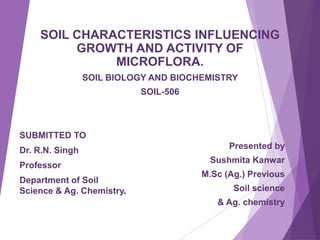
soil characteristics influencing growth and activity of microflora
- 1. SOIL CHARACTERISTICS INFLUENCING GROWTH AND ACTIVITY OF MICROFLORA. SOIL BIOLOGY AND BIOCHEMISTRY SOIL-506 Presented by Sushmita Kanwar M.Sc (Ag.) Previous Soil science & Ag. chemistry SUBMITTED TO Dr. R.N. Singh Professor Department of Soil Science & Ag. Chemistry.
- 2. INTRODUCTION Soil organism are creatures that spend all or part of their lives in the soil environment.It is classified into Soil fauna ,belong to animal form. eg.protozoa,ants,termites Soil flora, belong to plant kingdom.It is classified into two subgroups Macroflora-plant roots of higher plants Microflora-bacteria ,actinomycetes,fungi and algae
- 3. SOIL CHARACTERISTICS INFLUENCING GROWTH AND ACTIVITY OF MICROFLORA. Soil fertility Organic matter Soil moisture Soil temperature Soil aeration Soil pH (H-ion concentration) Cultural practices Nature of soil Microbial associations.
- 4. 1. Soil moisture: Water (soil moisture) is useful to the microorganisms in two ways It serve as source of nutrients and supplies hydrogen / oxygen to the organisms . It serve as solvent and carrier of other food nutrients to the microorganism. In the absence of adequate moisture in soil, some of microbes die out due to tissue dehydration and some of them change their forms into resting stages spores . Optimum soil moisture (range 20 to 60 %) must be there for better population and activity of microbes in soil.
- 5. 2. Soil temperature: Temperature is the most important environmental factor influencing the biological ,physical & chemical processes of microbes, microbial activity and population in soil. Depending upon the temperature range at which microorganisms can grow and function,they are divided into three groups Psychrophiles (microoranisms growing at low temperature below 10 °c)e.g.Pseudomonas fluorescens Mesophiles (microoranisms growing well in the temperature range of 20 ° C to 45° C)e.g.Escherichia coli Thermopiles (microoranisms can tolerate temperature above 45° c and optimum 45-60°C). E.g.Bacillus stearothemophilus
- 6. • Temperature affect microbial population and their activity especially in temperate regions. • In winter, when temperature is low , the number and activity of microorganisms falls down, and as the soils warms up in spring, they increases in number as well as activity
- 7. 3. Soil Reaction / Soil pH: Soil reactions also influence the type of the bacteria present in soil. Most of the soil bacteria, blue- green algae, diatoms and protozoa prefer a neutral or slightly alkaline reaction between pH 4.5 and 8.0 Fungi grow in acidic reaction between pH 4.5 and 6.5. While actinomycetes prefer slightly alkaline soil reactions.
- 8. 4. Soil air (Aeration): Activities of soil microbes is often measured in terms of the amount of oxygen absorbed or amount of CO2 evolved by the organisms in the soil environment. Depending upon oxygen requirements, soil microorganisms are grouped into categories Aerobic (require oxygen for processes) e.g.Azotobacter spp. Anaerobic (do not require oxygen)e.g.Clostridium Microaerophilic (requiring low concentration / level of oxygen).e.g.camplyobacter
- 9. 5.Cultural practices (Tillage): Ploughing and tillage operations facilitate aeration in soil and exposure of soil to sunshine and thereby increase the biological activity of organisms, particularly of bacteria. Crop rotation with legume maintains the favorable microbial population balance, particularly of N2 fixing bacteria and thereby improve soil fertility.
- 10. 6. ROOT EXUDATES: • Root exudates provide an abundant source of energy and nutrients and thus directly or indirectly influence the quality as well as quantity of microorganisms in the rhizosphere region. • Root exudates contain sugars, organic acids, amino acids, vitamins and other growth factors which have the profound effect on soil microbes.
- 11. 7. Soil Organic Matter The organic matter in soil being the chief source of energy and food for most of the soil organisms, it has great influence on the microbial population. It influences the structure and texture of soil and thereby activity of the microorganisms. The soil microbial biomass constitutes about 2-4%of the soil organic matter of soil.
- 12. 8.Microbial associations / interactions: The association existing between one organism and another whether of symbiotic or antagonistic influences the population and activity of soil microbes. The predatory habit of protozoa and some mycobacteria which feed on bacteria may suppress or eliminate certain bacteria. On the other hand, the activities of some of the microorganisms are beneficial to each other. for instance organic acids liberated by fungi, increase in oxygen by the activity of algae, change in soil reaction etc. favours the activity or bacteria and other organisms in soil.
- 13. 9.Nature of Soil: The physical, chemical and physico-chemical nature of soil and its nutrient status influence the microbial population both quantitatively and qualitatively. The soils in good physical condition have better aeration and moisture content which is essential for optimum microbial activity. Nutrients (macro and micro) and organic constituents of humus are responsible for absence or presence of certain type of microorganisms and their activity. For example activity and presence of nitrogen fixing bacteria is greatly influenced by the availability of molybdenum and absence of available phosphate restricts the growth of azotobacter.
- 14. Reference www.agriinfo.in Soil Microbiology and Biochemistry by Ghulam Hassan Dar
